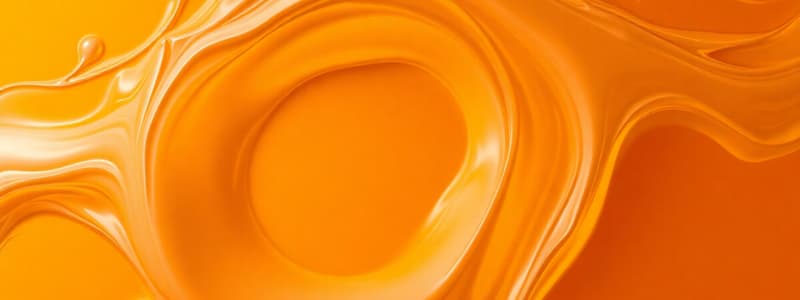Podcast
Questions and Answers
What does rheology primarily study?
What does rheology primarily study?
- The chemical reactions of pharmaceutical products
- The flow properties of matter (correct)
- The interactions between drugs and biological systems
- The structural design of pharmaceutical packaging
How does viscosity affect a fluid's behavior?
How does viscosity affect a fluid's behavior?
- It determines the internal friction and resistance to flow (correct)
- It completely prevents flow under any conditions
- It increases the speed of flow in all cases
- It has no effect on the molecular makeup of the fluid
What defines a Newtonian fluid?
What defines a Newtonian fluid?
- It does not exhibit any flow resistance
- It behaves differently under varying shear conditions
- It has a viscosity that increases with temperature
- It has a constant viscosity regardless of shear rate (correct)
In which pharmaceutical dosage form is rheology particularly important?
In which pharmaceutical dosage form is rheology particularly important?
What is the relationship between shearing stress and viscosity in a Newtonian fluid?
What is the relationship between shearing stress and viscosity in a Newtonian fluid?
What does the reciprocal of viscosity represent?
What does the reciprocal of viscosity represent?
What does a high viscosity fluid do in terms of flow?
What does a high viscosity fluid do in terms of flow?
Why is rheology significant in the formulation of lotions and creams?
Why is rheology significant in the formulation of lotions and creams?
In terms of flow, how are non-Newtonian fluids characterized?
In terms of flow, how are non-Newtonian fluids characterized?
What aspect of rheology can affect the bioavailability of drugs?
What aspect of rheology can affect the bioavailability of drugs?
What characterizes a Newtonian fluid?
What characterizes a Newtonian fluid?
What occurs in pseudoplastic flow when shearing stress is increased?
What occurs in pseudoplastic flow when shearing stress is increased?
What is an example of dilatant flow?
What is an example of dilatant flow?
How does the coefficient of viscosity (η) relate to shear stress and shear rate?
How does the coefficient of viscosity (η) relate to shear stress and shear rate?
What is a characteristic of dilatant fluids under increasing shearing stress?
What is a characteristic of dilatant fluids under increasing shearing stress?
What happens to macromolecules in a pseudoplastic fluid when shearing stress is applied?
What happens to macromolecules in a pseudoplastic fluid when shearing stress is applied?
What is the effect of decreasing shearing stress on a pseudoplastic fluid?
What is the effect of decreasing shearing stress on a pseudoplastic fluid?
Which of the following describes the relationship of shearing stress to viscosity in dilatant flow?
Which of the following describes the relationship of shearing stress to viscosity in dilatant flow?
In the equation η = F/A/(dv/dx), what does F/A represent?
In the equation η = F/A/(dv/dx), what does F/A represent?
Flashcards
Newtonian Fluid
Newtonian Fluid
The relationship between shear stress and shear rate is directly proportional, meaning the force needed to deform the fluid increases linearly with the rate of deformation.
Viscosity
Viscosity
The resistance of a fluid to flow. The higher the viscosity, the more force is needed to make it flow.
Non-Newtonian Fluid
Non-Newtonian Fluid
A fluid that does not follow a linear relationship between shear stress and shear rate. Its viscosity changes with the applied force.
Pseudoplastic Flow (Shear-thinning)
Pseudoplastic Flow (Shear-thinning)
Signup and view all the flashcards
Dilatant Flow (Shear-thickening)
Dilatant Flow (Shear-thickening)
Signup and view all the flashcards
Plastic Flow
Plastic Flow
Signup and view all the flashcards
Shear stress
Shear stress
Signup and view all the flashcards
Shear rate
Shear rate
Signup and view all the flashcards
Molecular alignment
Molecular alignment
Signup and view all the flashcards
Shear-thinning
Shear-thinning
Signup and view all the flashcards
What is Rheology?
What is Rheology?
Signup and view all the flashcards
What is Viscosity?
What is Viscosity?
Signup and view all the flashcards
What is a Newtonian Fluid?
What is a Newtonian Fluid?
Signup and view all the flashcards
What is Velocity Gradient?
What is Velocity Gradient?
Signup and view all the flashcards
What is Shearing Stress?
What is Shearing Stress?
Signup and view all the flashcards
What is a Non-Newtonian Fluid?
What is a Non-Newtonian Fluid?
Signup and view all the flashcards
What is Fluidity?
What is Fluidity?
Signup and view all the flashcards
How does Rheology Impact Product Manufacturing?
How does Rheology Impact Product Manufacturing?
Signup and view all the flashcards
How does Rheology Affect Product Stability and Bioavailability?
How does Rheology Affect Product Stability and Bioavailability?
Signup and view all the flashcards
How does Rheology Impact Patient Acceptability?
How does Rheology Impact Patient Acceptability?
Signup and view all the flashcards
Study Notes
Rheology Overview
- Rheology is the science of flow properties of matter under stress
- Originates from Greek words "rheo" (flow) and "logos" (science)
- Helps understand fluid-type preparations' flow in pharmaceutical and related areas (e.g., pouring, extrusion, spreading)
- Important for measuring the ease of pouring, extruding semisolid dosage forms, spreading on skin, and passage through needles
Viscosity
- Viscosity is the resistance of a liquid to flow
- High viscosity = resists flow due to high internal friction
- Low viscosity = flows easily due to low internal friction
- Determines how a liquid behaves under stress or force
Types of Viscosity
- Kinematic Viscosity: Calculated by dividing Newtonian viscosity by density, denoted by (u)
- Relative Viscosity: Ratio of dispersion viscosity (η) to solvent viscosity (ηo), denoted by (nr)
Types of Fluids
-
Newtonian Fluids: Flow properties are directly proportional to the applied stress and the rate of shear (e.g., water, some thin liquids)
-
Force required for one layer to slip past another depends on viscosity, exposed areas, and distance between surfaces
-
Shear stress (force/unit area) needed increases with viscosity
-
Formula: F/A = η (dv/dx) where F/A = shearing stress, dv/dx = rate of shear, η = viscosity
-
Non-Newtonian Fluids: Flow properties are not directly proportional to the applied stress and rate of shear (e.g., many foods, paints, suspensions)
-
Plastic Flow: Flow doesn't occur until a certain yield value (f) or stress is reached; the viscosity is defined as (F - f)/G
-
Pseudoplastic Flow (Shear-thinning): Viscosity decreases with increasing shear; molecules align with flow and reduces friction (e.g., paints, some polymers)
-
Dilatant Flow (Shear-thickening): Viscosity increases with increasing shear; particles rearrange and increase friction during flow; (e.g., concentrated suspensions, some doughs)
Additional Notes
- Corn starch suspension is a real-world example of a dilatant fluid
- Different flow behaviors (Newtonian, plastic, pseudoplastic, dilatant) are represented by different graphical relationships between shear stress and shear rate
- Flow characteristics are crucial in pharmaceutical and cosmetic product development and application.
Studying That Suits You
Use AI to generate personalized quizzes and flashcards to suit your learning preferences.




